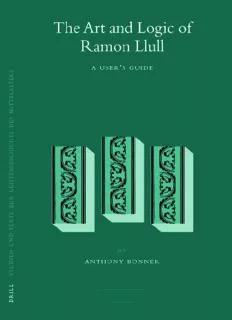
The Art and Logic of Ramon Llull: A User's Guide (Studien Und Texte Zur Geistesgeschichte Des Mittelalters) PDF
Preview The Art and Logic of Ramon Llull: A User's Guide (Studien Und Texte Zur Geistesgeschichte Des Mittelalters)
The Art and Logic of Ramon Llull BOONER_f1_i-xx.indd i 10/2/2007 1:00:20 PM Studien und Texte zur Geistesgeschichte des Mittelalters Begründet von Josef Koch Weitergeführt von Paul Wilpert, Albert Zimmermann und Jan A. Aertsen Herausgegeben von Andreas Speer In Zusammenarbeit mit Tzotcho Boiadjiev, Kent Emery, Jr. und Wouter Goris BAND XCV BOONER_f1_i-xx.indd ii 10/2/2007 1:00:21 PM The Art and Logic of Ramon Llull A User’s Guide by Anthony Bonner LEIDEN • BOSTON 2007 BOONER_f1_i-xx.indd iii 10/2/2007 1:00:21 PM This book is printed on acid-free paper. A C.I.P. record for this book is available from the Library of Congress ISSN 0169–8028 ISBN 978 90 04 16325 6 © Copyright 2007 by Koninklijke Brill NV, Leiden, The Netherlands. Koninklijke Brill NV incorporates the imprints Brill, Hotei Publishing, IDC Publishers, Martinus Nijhoff Publishers and VSP. All rights reserved. No part of this publication may be reproduced, translated, stored in a retrieval system, or transmitted in any form or by any means, electronic, mechanical, photocopying, recording or otherwise, without prior written permission from the publisher. Authorization to photocopy items for internal or personal use is granted by Koninklijke Brill NV provided that the appropriate fees are paid directly to The Copyright Clearance Center, 222 Rosewood Drive, Suite 910, Danvers, MA 01923, USA. Fees are subject to change. printed in the netherlands BOONER_f1_i-xx.indd iv 10/5/2007 10:59:30 AM To the memory of Robert Pring-Mill and David Rosenblatt BOONER_f1_i-xx.indd v 10/2/2007 1:00:21 PM BOONER_f1_i-xx.indd vi 10/2/2007 1:00:22 PM CONTENTS Preface ......................................................................................... ix Acknowledgments ....................................................................... xv Abbreviations .............................................................................. xvii List of Illustrations ...................................................................... xix 1. Introduction ............................................................................ 1 2. The quaternary phase ............................................................ 26 3. Changes in the Art during the quaternary phase, and the transition to the ternary phase ........................................ 93 4. The ternary phase .................................................................. 121 5. The post-Art phase: logic ...................................................... 188 6. Overview ................................................................................ 256 Appendices .................................................................................. 301 The Martin Gardner Problem ............................................... 303 Chronological list of Llull’s works .......................................... 306 Bibliography ................................................................................ 311 Index of Lullian works ............................................................... 321 Index of names and subjects ...................................................... 325 BOONER_f1_i-xx.indd vii 10/2/2007 1:00:22 PM BOONER_f1_i-xx.indd viii 10/2/2007 1:00:22 PM PREFACE This is a book about method, not content; about the how, not the what. This does not mean that the one is independent of the other, that the form of Ramon Llull’s message did not deeply in(cid:2) uence its matter, or, more importantly, that the matter and, above all, its goals, were not primary in determining its form. We will, in fact, frequently touch on such subjects, but only as they come up in connection with the form. It is therefore a question of priorities; as Llull would have put it, the (cid:3) rst intention of this book is the method, and the second intention the content. Even though, in the course of developing his method, Llull made frequent and important programmatic statements presenting its founda- tions, these should not be confused with the method itself, any more than we should confuse the foundations of a building with the (cid:3) nished edi(cid:3) ce. In both cases they can only provide a beginning for a future exploration of the structure. Moreover, Llull was not a speculative theologian, philosopher, or logician. His study of these subjects is never an end in itself, but only the means to an end. For the purposes of this book, it means that his interest in logic—and this applies to the Art insofar as it constitutes a logical system—is not theoretical but practi- cal. His is not a logica docens, speculativa, or theorica, but rather what the Middle Ages called logica utens, one to be judged by its usefulness. Since his logic was directed to producing what he called ‘necessary reasons’, it is these arguments to which we must turn our attention, to see what it was about them that he felt justi(cid:3) ed in considering ‘necessary’. This is particularly urgent because in the past a great deal of research has gone into these ‘necessary reasons’, but mostly from the perspective of what they imply concerning the question of faith vs. reason. Even more research has gone into the bases of the Art—the Dignities, the components of (cid:3) gures such as S and T, the Nine Subjects, etc. Singularly little effort, however, has gone into trying to bridge the gap between the theoretical foundations of Llull’s Art and logic, or between its bases and their (cid:3) nal expression in patterns of argument, and perhaps even less in the actual study of these patterns, which in fact constituted his ‘necessary reasons’, the backbone of his entire endeavor. BOONER_f1_i-xx.indd ix 10/2/2007 1:00:22 PM
Description: